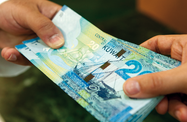Increased government spending and higher oil prices are set to drive growth in Kuwait’s banking sector, with increased profits and liquidity supporting a recent rebound in activity.

A report on the banking sector released by research firm Marmore MENA Intelligence on May 23 has forecast a strengthening of profitability of domestic banks in the near and medium term, predicting loan growth of 4% in FY 2018/19, up from last year’s expansion of 2.8%.
The forecast loan growth comes amid a rebound in the banking sector following three years of slower expansion brought on by lower oil prices.
Banking profits grew by 8.9% last year, according to KPMG, with all but two banks operating in the market reporting higher net profits than the previous year.
Total assets also expanded by 5.9% to $251.9bn, with KPMG citing the fact that three banks had accessed the international debt markets to raise $9.5bn as a sign of confidence in the sector.
National Development Plan supporting lending
Much of the positivity in the banking sector comes amid higher levels of state spending, as the government implements its current five-year National Development Plan (NDP) FY 2015/16-2019/20.
Under the NDP the government intends to spend KD34bn ($112.2bn) on some 521 projects over the period. As part of this, the Annual Plan 2017/18, which ran from April 1 to March 31, was focused on 164 projects, with KD4.8bn ($15.7bn) of the KD21.2bn ($69.9bn) state budget set aside for their development.
“Government project spending is the backbone of the Kuwaiti economy,” Rani Selwanes, head of investment banking for local financial services firm NBK Capital, told OBG.
While estimated expenditure under the 2017/18 budget was 5% higher than in 2016/17, the figure for 2018/19 represents a 1.4% increase at KD21.5bn ($70.9bn).
Meanwhile, following a 2.5% contraction last year, GDP is expected to expand by 1.3% in 2018 to KD39.9bn ($131.6bn), according to the IMF, before rising by 3.8% and 3.9% in 2019 and 2020, respectively.
Rising oil prices to improve sector outlook
Another factor expected to support growth and liquidity in the banking industry is the sustained rebound in global oil prices.
Brent crude has risen steadily recently, increasing from a low of $35 per barrel in January 2016 to around $75 a barrel as of mid-2018.
Given that some 70% of government revenues were derived from oil last year, the increase in global prices will not only boost state coffers, but also drive private sector credit growth.
Banks transition to IFRS 9
The sector’s prospects have been improving as lenders adapt to the International Accounting Standards Board's ninth International Financial Reporting Standards (IFRS 9), which came into effect at the beginning of the year.
The new accounting measures are expected to shift the way in which banks operate, forcing them to take a more forward-looking approach to provisioning.
While general consensus before the rollout was that GCC banks would be able to deal with the transition due to their conservative approach to loan-loss provisioning, local media reported in June that some domestic financial institutions were having difficulty implementing the standards due to contraventions with sharia.
Nonetheless, the general provisions accumulated by Kuwaiti banks in recent years, which include setting aside provisions on performing facilities equivalent to 1% of cash facilities and 0.5% of non-cash facilities, coupled with comfortable liquidity buffers and low levels of non-performing loans (NPLs), should ensure a relatively smooth transition to IFRS 9.
“At below 2.5%, the NPL ratio in Kuwait is lower than other GCC countries, despite the challenging economic environment brought on by the sharp drop in oil prices since 2014,” Fatah Adour, general manager of Citibank Kuwait, told OBG. “The banking sector also holds impressive balance sheet capital adequacy ratios, as a result of a prudent provisions approach, as well as the prompt implementation of LCR [liquidity coverage ratio], NSFR [net stable funding ratio] and more recently the IFRS 9 standards.”


